Learn about the best radish companion plants you can surround your radishes with to help your radishes thrive and produce bountiful crops. Find out what you can plant next to radishes and what you should not plant near radishes. Get ideas about which flowers grow well with radishes, which herbs grow well with radishes, which fruit grows well with radishes, and which vegetables grow well with radishes.
You will also learn about the best place to plant radishes, the best fertilizer for radishes, and whether radishes need a lot of water. I’ve been growing and harvesting radishes for over 20 years (as a special favor to my husband) and using radishes in salads or just having a bowl of freshly picked radishes to munch on. If you are looking for an easy-to-grow, deer-resistant addition to your plant collection, read on to learn how simple it is to grow radishes in your garden. Get a handy chart listing companion plants for radishes as well. Let’s get started!
Table of Contents
Why I Grow Radishes
I don’t eat a lot of radishes, to be honest. When it comes to anything spicy, I am a wimp. I grow radishes for two main reasons: My husband loves them, and they are super easy to grow. We get a lot of deer coming through our property, and I have to be very proactive to prevent deer damage, especially in the vegetable garden. I like to plant things that the deer do not like to eat. Radishes fall into that category, and they reliably do well in our Zone 8 vegetable garden. I can always count on radishes to sprout and produce a bountiful crop. The challenge we have is eating them all. If you want to feel like a successful gardener, grow some radishes!
What Makes a Good Companion Plant?
Why pay attention to companion plants? A good companion plant is one that offers various benefits to its neighboring plants, such as minimizing pest and disease issues, which helps enhance their growth, health, and overall productivity. Here are some key qualities that make a good companion plant that will help you plant strategically to make the most of your yard or garden space:
Pest Control: Companion plants may repel pests or attract beneficial insects that prey on pests, helping to reduce pest damage without the need for chemical pesticides.
Pollinator Attraction: Plants that attract pollinators such as bees, butterflies, and hummingbirds can improve pollination and fruit set in neighboring plants, leading to higher yields.
Soil Improvement: Some companion plants have deep roots that help break up compacted soil, while others fix nitrogen or add organic matter to the soil, improving soil fertility and structure for neighboring plants.
Complementary Growth Habits: Companion plants with different growth habits, such as tall plants providing shade for shorter ones or ground covers suppressing weeds, can maximize space and resources in the garden.
Disease Resistance: Certain companion plants may emit chemicals or compounds that inhibit the growth of pathogens or pests, reducing the risk of disease in neighboring plants.
Seasonal Considerations: Companion plants that thrive during different seasons can provide continuous benefits throughout the year, such as early bloomers attracting pollinators or cover crops protecting soil during the off-season.
Aesthetic Value: Companion plants with attractive foliage, flowers, or fruits can enhance the visual appeal of the garden while providing practical benefits to neighboring plants.
What do radishes like to be planted by?
A good companion plant to radishes is any plant that helps the radishes to thrive while thriving itself. Radishes and their companion plants should both receive benefits from being planted near each other, whether it is keeping away pests or offering a benefit to the soil. Read on for the list of the best radish companions.
Radish Companion Plants: Flowers
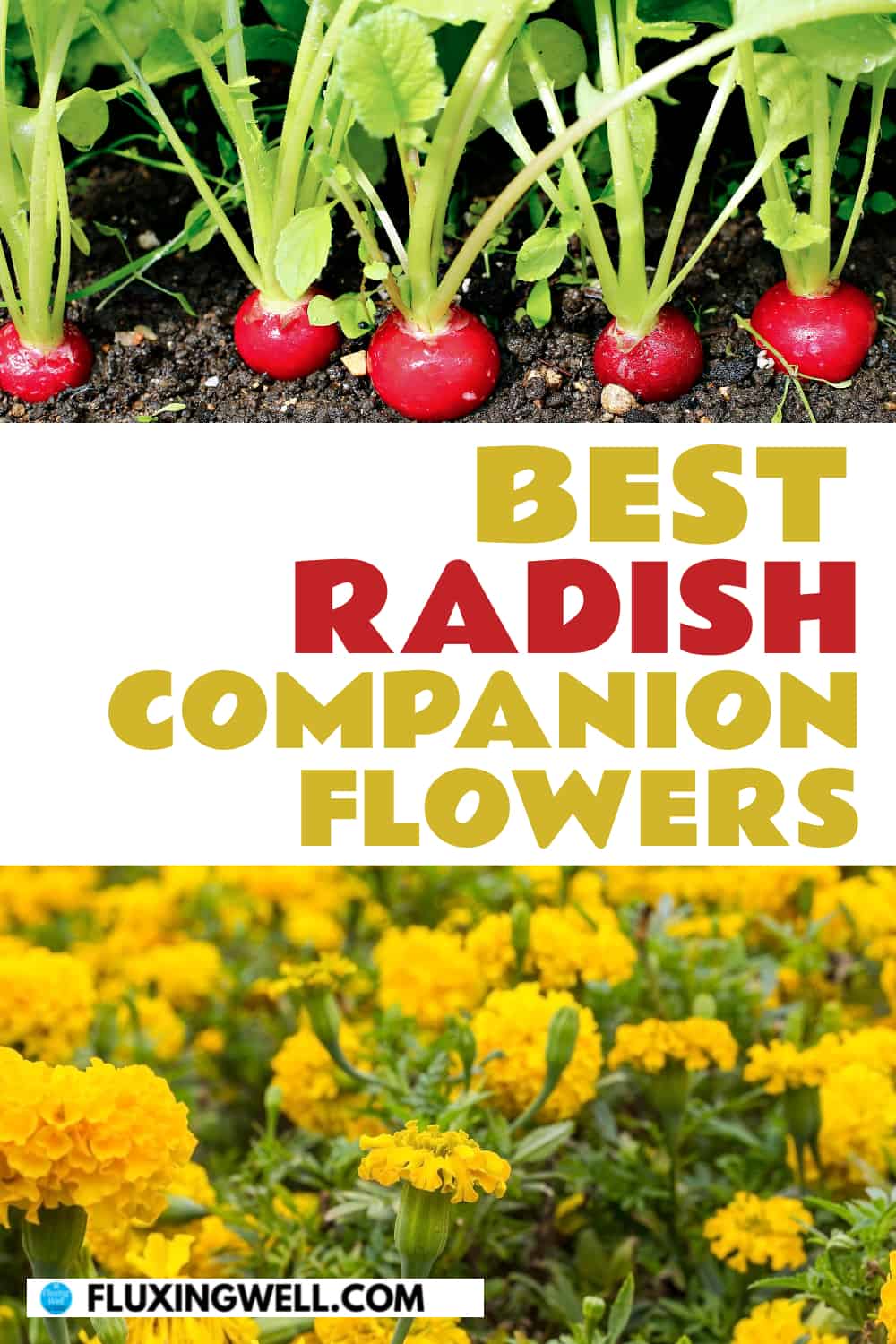
By planting companion flowers alongside radishes, you can create a biodiverse and pest-resistant garden ecosystem that supports healthy plant growth and enhances overall yields. Here are some excellent companion flowers for radishes and the reasons why they work well together:
Alyssum (Lobularia maritima): Alyssum flowers attract beneficial insects like predatory wasps and hoverflies, which feed on pests like aphids and caterpillars that can harm radish plants. Their low-growing habit makes them ideal ground cover, suppressing weeds and conserving soil moisture.
Calendula (Calendula officinalis): Calendula flowers attract beneficial insects such as hoverflies and parasitic wasps, which prey on pests like aphids and caterpillars that can harm radish plants. Additionally, calendula’s bright blooms add beauty to the garden and can be used for medicinal and culinary purposes.
Cosmos (Cosmos spp.): Cosmos flowers attract pollinators such as bees, butterflies, and hoverflies, which can enhance fruit set and yield in radish plants. Additionally, cosmos add height and color to the garden, creating visual interest.
Marigolds (Tagetes spp.): Marigolds emit a strong scent that deters pests like nematodes, aphids, and flea beetles, which can harm radish plants. Interplanting marigolds with radishes can help protect them from infestation while adding vibrant color to the garden.
Nasturtiums (Tropaeolum majus): Nasturtiums are excellent companions for radishes because they repel pests such as aphids, cucumber beetles, and whiteflies, which can damage radish plants. Additionally, nasturtiums attract predatory insects like ladybugs and lacewings, which feed on pests, contributing to pest control in the garden.
Radish Companion Plants: Fruit
Radishes can benefit from companion fruits that provide various advantages such as pollination support, pest control, and soil improvement. Here are some excellent companion fruit plants for radishes and the reasons why they make good companions:
Apple Trees (Malus domestica): Apple trees attract pollinators such as bees, which can help increase radish yields. Additionally, radishes may help repel certain pests that can harm apple trees, creating a mutually beneficial relationship.
Berry Bushes (e.g., Raspberry, Blackberry, Blueberry): Berry bushes provide food and habitat for beneficial insects and birds, which can help control pests in the garden. Radishes, in turn, can help repel certain pests that could affect berry bushes, contributing to overall plant health.
Currant Bushes (Ribes spp.): Currant bushes attract pollinators and beneficial insects while providing shade and wind protection for radishes. Radishes, in turn, may help deter pests that can damage currant bushes, promoting a healthier growing environment.
Elderberry Bushes (Sambucus spp.): Elderberry bushes attract beneficial insects such as pollinators and predatory insects, which can help control pests in the garden. Radishes, in turn, may help deter pests that can harm elderberry bushes, creating a mutually beneficial relationship.
Gooseberry Bushes (Ribes uva-crispa): Gooseberry bushes provide shade, wind protection, and additional fruit for harvest while attracting pollinators and beneficial insects. Radishes, with their aromatic foliage, may help repel certain pests that could affect gooseberry bushes.
Peach Trees (Prunus persica): Peach trees provide shade and wind protection for radishes, creating a microclimate that supports healthy plant growth. Radishes, in turn, may help deter pests that can damage peach trees, contributing to overall plant health.
Plum Trees (Prunus domestica): Plum trees attract pollinators and can benefit from the presence of radishes for increased pollination. Radishes, in turn, may help repel certain pests that could affect plum trees, promoting a healthier growing environment.
Radish Companion Plants: Herbs
Planting companion herbs alongside radishes is another way you can create a diverse and pest-resistant garden ecosystem. Here are some beneficial companion herbs for radishes and the reasons why they make good companions:
Basil (Ocimum basilicum): Basil is a great companion for radishes because it helps repel pests like aphids, thrips, and spider mites, which can damage radish plants. Additionally, basil attracts beneficial insects such as bees and predatory insects, contributing to pest control in the garden.
Chamomile (Matricaria chamomilla): Chamomile attracts beneficial insects such as hoverflies and parasitic wasps, which prey on pests that can damage radish plants. Its delicate flowers add beauty to the garden while providing practical benefits.
Cilantro (Coriandrum sativum): Cilantro attracts beneficial insects such as lacewings and parasitic wasps, which feed on pests like aphids and spider mites that can harm radish plants. Its feathery foliage also provides shade and moisture retention for radish plants.
Dill (Anethum graveolens): Dill attracts beneficial insects such as predatory wasps and ladybugs, which prey on pests like aphids and caterpillars that can harm radish plants. Additionally, dill’s airy foliage allows sunlight to reach the radish plants while providing a natural pest control solution.
Lavender (Lavandula spp.): Lavender attracts pollinators such as bees and butterflies, which can help increase seed production and yield in radish plants. Its aromatic foliage also repels pests like aphids and spider mites, benefiting radish plants.
Parsley (Petroselinum crispum): Parsley attracts beneficial insects such as hoverflies and parasitic wasps, which prey on pests like aphids and caterpillars that can harm radish plants. Its dense foliage also acts as a natural mulch, helping to retain soil moisture and suppress weeds.
Rosemary (Rosmarinus officinalis): Rosemary repels pests such as carrot flies and cabbage moths, which can harm radish plants. Additionally, rosemary’s aromatic foliage can help mask the scent of radish plants, making them less attractive to pests.
Thyme (Thymus spp.): Thyme emits a strong scent that repels pests like cabbage worms and slugs, which can damage radish plants. Interplanting thyme with radishes can help protect them from infestation while providing a drought-tolerant and aromatic herb for culinary use.
Radish Companion Plants: Vegetables
By planting these companion vegetables alongside radishes, you can create a biodiverse and mutually beneficial garden ecosystem. Here are some beneficial companion vegetables for radishes and the reasons why they make good companions:
Beets (Beta vulgaris): Radishes and beets are both root vegetables and have similar growing requirements. Interplanting radishes with beets can help break up compacted soil and improve soil aeration, leading to healthier root development for both crops. Additionally, radishes can help deter pests like aphids and flea beetles, which can damage beet plants. Since I only plant about half a row of radishes at one time, I usually plant the other half of the row with beets. This arrangement has worked well for years.
Carrots (Daucus carota): Radishes and carrots are known as “sister plants” and grow well together because they have different root depths. Radishes grow quickly and help break up compacted soil, making it easier for carrots to grow deeper roots. Additionally, radishes can help deter pests like carrot flies, which can damage carrot plants.
Lettuce (Lactuca sativa): Radishes and lettuce have similar growing requirements and can be interplanted to maximize space in the garden. Lettuce’s shallow roots make it a compatible companion for radishes, and it helps suppress weeds while providing a leafy green crop for harvest.
Onions (Allium cepa): Radishes and onions are compatible companions in the garden and can be interplanted to maximize space. Onions’ strong scent may help deter pests like aphids and carrot flies, which can damage radish plants, and radishes can help deter pests like root maggots, which can affect onion plants.
Scallions (Allium fistulosum): Radishes and scallions are compatible companions in the garden and can be interplanted to maximize space. Scallions’ upright growth habit makes them a suitable companion for radishes, and both crops benefit from the other’s presence by deterring pests and providing shade.
Spinach (Spinacia oleracea): Radishes and spinach have complementary growth habits and can be interplanted to maximize space in the garden. Spinach’s shade-tolerance makes it a suitable companion for radishes, and both crops benefit from the other’s presence by providing shade and reducing soil erosion.
What Should Not Be Planted with Radishes?
Due to growing needs and competition for resources, there are a few plants that should not be planted near radishes. Here is the list of plants to avoid:
Beans and Peas: Avoid planting beans and peas near radishes as they belong to the legume family and can fix nitrogen in the soil, leading to excessive foliage growth but poor root development in radishes.
Hyssop: Hyssop is believed to inhibit the growth of radishes when planted nearby due to its allelopathic properties, which can interfere with radish germination and growth.
Potatoes: Planting radishes near potatoes is not recommended as it may attract the Colorado potato beetle, which can damage both crops. Additionally, potatoes and radishes have different soil requirements, making them less compatible when planted together.
Turnips: Turnips can compete with radishes for space, nutrients, and water, leading to reduced yields for both crops. It’s best to plant them separately to ensure optimal growth and harvest.
Brassicas: Radishes are also brassicas, so planting them too close to other brassica crops like cabbage, broccoli, or cauliflower can result in competition for resources and potential pest and disease issues. It’s advisable to rotate these crops to different areas of the garden each season to minimize these problems.
Radish Companion Planting Chart
| Radish Companion Plants | |
| Radish Companion Plants: Flowers | Radish Companion Plants: Fruit |
| Alyssum | Apples |
| Calendula | Blackberries |
| Cosmos | Blueberries |
| Marigolds | Currants |
| Nasturtiums | Elderberries |
| Gooseberries | |
| Radish Companion Plants: Herbs | Peaches |
| Basil | Plums |
| Chamomile | Raspberries |
| Cilantro | |
| Dill | Radish Companion Plants: Vegetables |
| Lavender | Beets |
| Parsley | Carrots |
| Rosemary | Lettuce |
| Thyme | Onions |
| Scallions | |
| Worst Radish Companion Plants | Spinach |
| Beans | |
| Broccoli | |
| Cabbage | |
| Cauliflower | |
| Hyssop | |
| Peas | |
| Potatoes | |
| Turnips | |
Common Questions About Planting and Growing Radishes
What is the best fertilizer for radishes?
A balanced fertilizer with a ratio such as 10-10-10 (N-P-K) is generally suitable for radishes. This type of fertilizer provides a good balance of nitrogen, phosphorus, and potassium, promoting healthy leaf growth, root development, and overall plant vigor. Additionally, incorporating organic matter such as compost into the soil can also enhance soil fertility and support radish growth.
How much water do radishes need?
Radishes typically require consistent moisture throughout their growth period. Water them regularly, aiming to keep the soil consistently moist but not waterlogged. Generally, radishes need about 1 inch of water per week, either from rainfall or supplemental watering, depending on the weather conditions and soil moisture levels. Adjust watering frequency based on environmental factors such as temperature and humidity to ensure optimal growth and prevent the soil from drying out. I like to water my vegetable garden with a watering wand, especially at the beginning of the season, to keep an eye on the weeds and new sprouts.
How much sun do radishes need?
Radishes thrive in full sunlight, requiring at least 6 hours of direct sunlight per day for optimal growth. Plant them in a location with plenty of sunlight to promote healthy leaf and root development. While radishes can tolerate some shade, they may produce smaller or slower-growing roots if they don’t receive enough sunlight. Therefore, it’s best to plant them in a sunny spot to maximize their growth potential and yield.
What kind of soil do radishes need?
Radishes prefer well-draining, loose, and fertile soil with a slightly acidic to neutral pH level between 6.0 and 7.0. Sandy loam or loamy soil types are ideal for radishes, as they allow for good root development and easy penetration for radish bulbs to grow. Additionally, incorporating organic matter such as compost into the soil can improve its structure, fertility, and moisture retention, providing an optimal growing environment for radishes.
What is the secret to growing radishes?
The secret to growing radishes successfully lies in providing them with the right growing conditions: ample sunlight, well-draining soil, consistent moisture, and adequate spacing. Radishes have always done very well in our garden, which I have appreciated over the years, even though I do not like to eat them. I always plant radish seeds directly in the garden, ensuring they’re sown at the correct depth and spaced according to the variety’s recommendations. Keep the soil consistently moist but not waterlogged, and thin seedlings as needed to prevent overcrowding. Additionally, avoid planting radishes in soil that’s too compacted or has too much nitrogen, as this can result in lush foliage but stunted root growth. With proper care and attention to these factors, you can enjoy a bountiful harvest of crisp, flavorful radishes.
How long does it take for radishes to grow?
Radishes are known for their quick growth, typically taking about 3 to 4 weeks to reach maturity from the time of planting. They are some of the first vegetable sprouts we see every year. However, this can vary depending on the variety of radish, environmental conditions such as temperature and soil moisture, and cultural practices such as thinning and spacing. Some varieties, such as smaller, round radishes, may mature even faster, sometimes in as little as 3 weeks, while larger varieties may take slightly longer. Regular monitoring of the radishes’ growth and readiness for harvest is key to ensuring they’re harvested at their peak flavor and texture.
How much space do radishes need?
Radishes don’t require a lot of space and can be planted relatively close together. Generally, space radish seeds or seedlings about 1 to 2 inches apart in rows spaced approximately 6 to 12 inches apart. This spacing allows enough room for the radish roots to develop without overcrowding, resulting in larger and healthier radishes. However, some smaller or round radish varieties can be planted even closer together, while larger varieties may benefit from slightly wider spacing. Adjust spacing based on the specific requirements of the radish variety you’re growing and the size of the mature roots.
Need More Planting Ideas?
Check out the tips for the best companion plants for eggplant to learn what to grow with those beauties. If you like the idea of companion planting, you might be interested in reading about the best companion plants for pumpkins, sunflowers, garlic, asparagus, rosemary, thyme, or the best companion plants for lavender. Get tips for growing stunning dahlias. Are you a beginning gardener? Try planting some foolproof, easy-care perennials, or learning about the best companion plants for columbine. There are so many exciting plants to grow!
Keep Track of Your Garden with a Journal Logbook
Now that you have learned about some compatible companion plants, keep track of your planting ideas, goals, and plans with a printable, editable free garden journal logbook. Choose the pages you want to use and customize them as you wish to record monthly, weekly, and daily garden tasks, lists, weather, and planting arrangements. There are also grid pages for easily designing the layout of your vegetable garden, flower garden, or landscape. Print it out and put it into a notebook you can take with you to the garden (that’s what I do). It’s nice to have all of your garden information in one place.
Get the garden journal logbook!
Free Online Garden Planner Layout Template
Now that you know which are the best companion plants for radishes, you might need a way to plan your garden layout. Whether you are planting vegetables, flowers, or herbs near your radish plants, this online garden planner can help you visualize your design and bring it to life. Arrange and rearrange the plants over and over, then print the layout when you are satisfied. With garden tasks that need your attention, this is one way to save time.
It’s fully customizable when you make your own copy and includes two editable chart pages for noting planting specifications.
Get my free online garden layout planner template!
Have a wonderful week, and may all of your radish-growing endeavors meet with success!

Lisa Mitchell is a wife, mom, and school librarian who likes to grow fruit, herbs, vegetables, and flowers on her family’s small Pacific Northwest farm. To learn more about what this website has to offer gardeners, click on over to the Garden page.
Like what you read here? Please give it a share!
Want more great garden, food, or travel ideas? Follow FluxingWell on Pinterest, Facebook, Instagram, and X for the latest posts, tips, and inspiration.

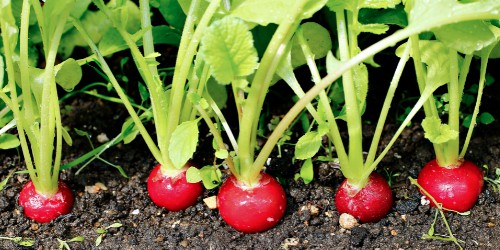

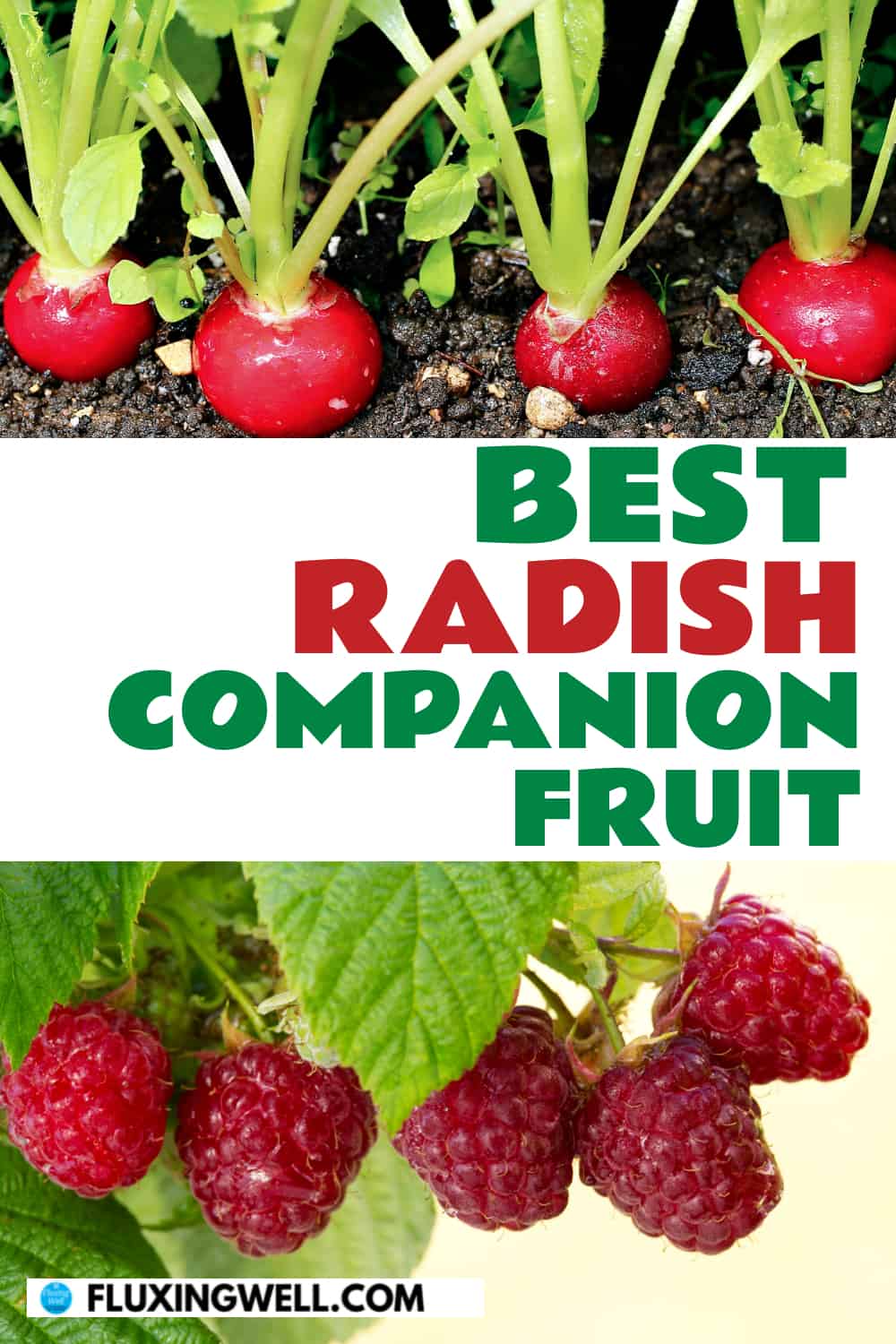
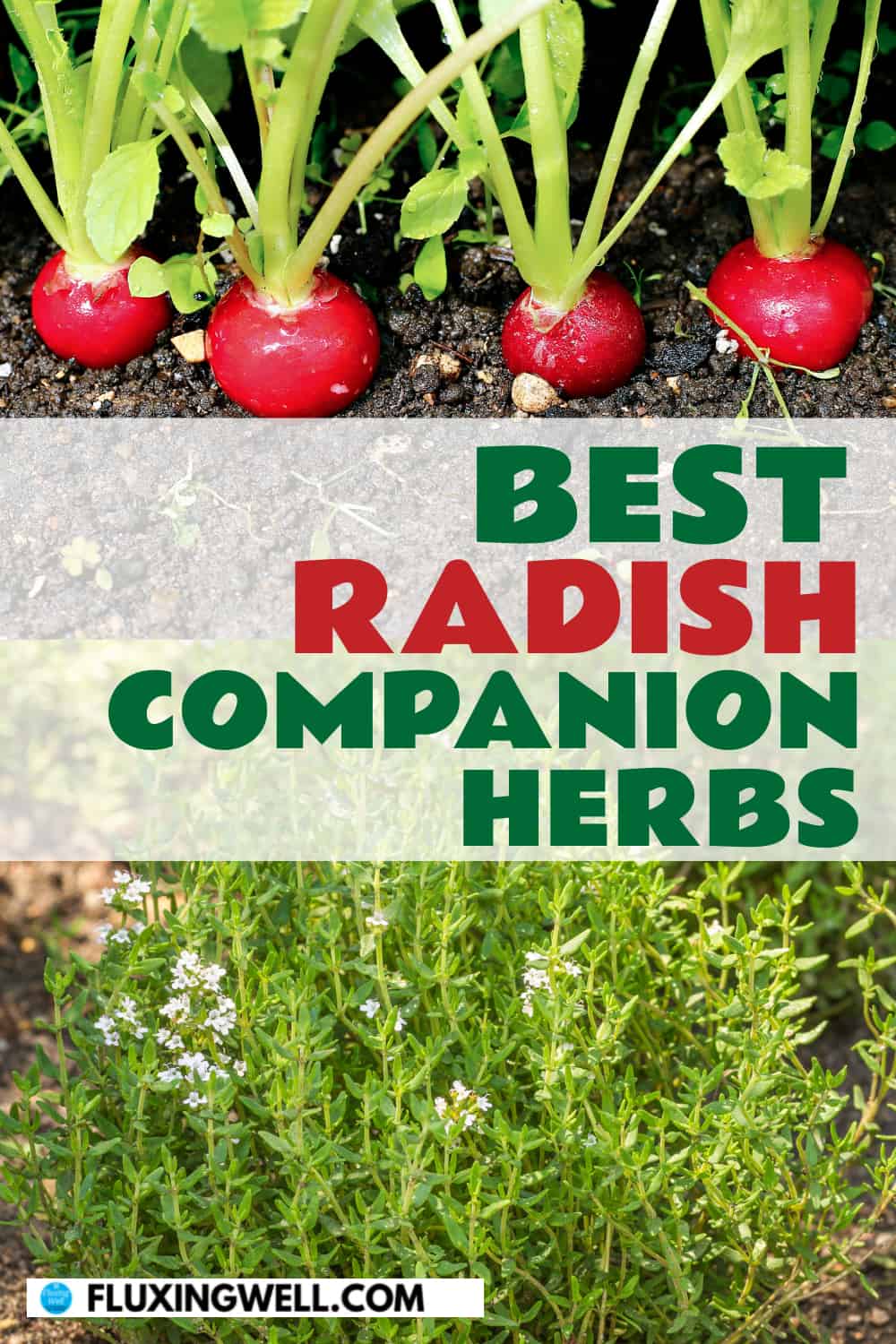
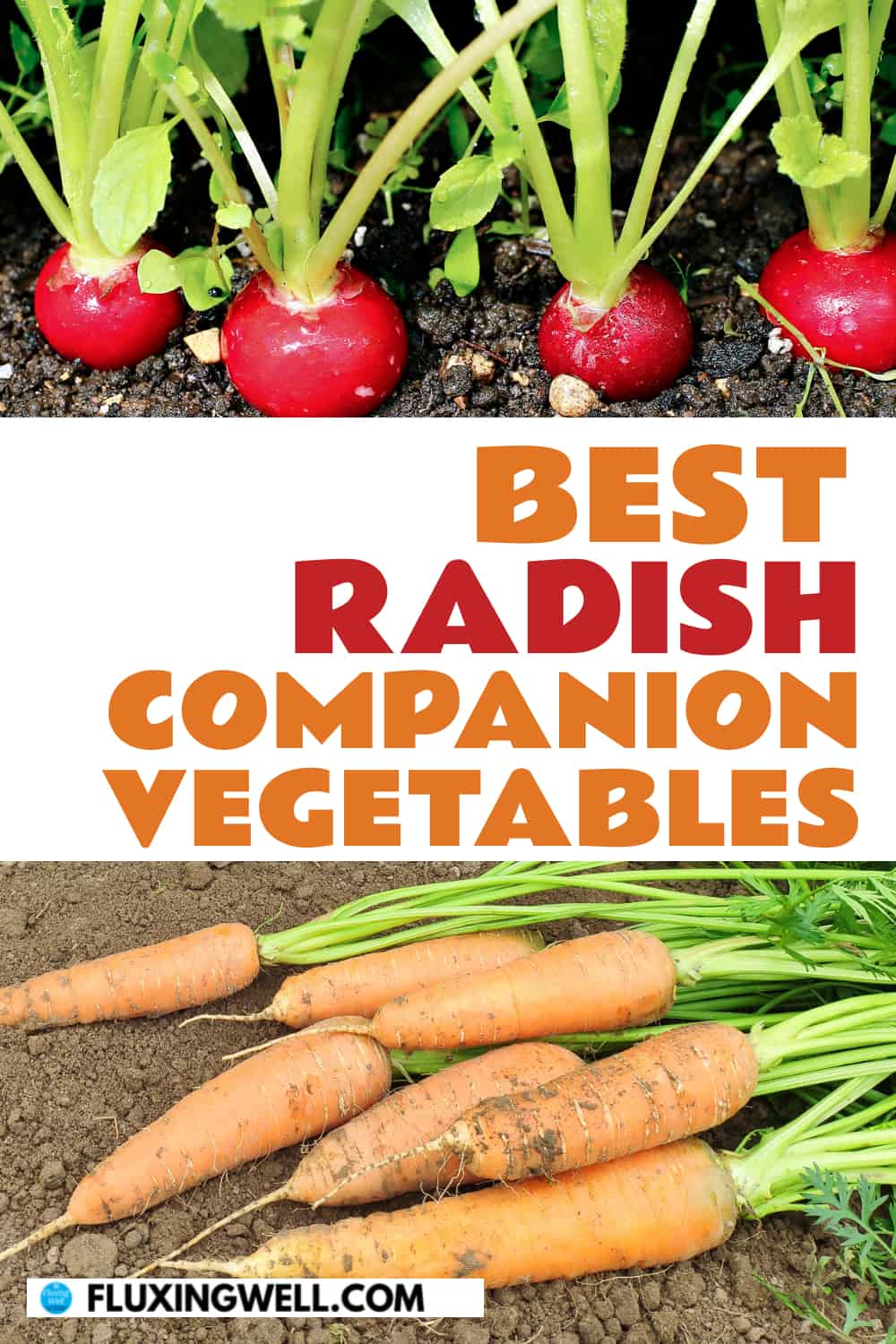


I don’t often eat radishes but they are delicious. These would be great to grow with my son and I know just the container!! Thanks for sharing!
You are most welcome! Yes, radishes are a super easy crop to try with kids to get them excited about gardening.
Thank you for sharing your best radish companion plants list. These growing tips included are so helpful along with the water, sun, and soil advice as well.
You are welcome. I always feel like a successful gardener when I grow radishes.
Thanks for this list of companion plants for radishes. It will be helpful for designing my garden plan this year.
Great! Good luck with designing your garden plan. I hope your radish crop is a great success.
Love it, very informational!
Thank you!
Nice list of radish companion plants! I like to grow radishes, but never thought much about what should be planted with them as companions. Thanks for the planting tips and ideas.
I am so glad you plant radishes and that you like the list of radish companion plants. Happy gardening!